
On the top of Dangrek Mountain, Preah Vihear Temple appears majestically in the sky with ancient beauty and mysterious historical stories. What makes this place a World Heritage Site and a must-see destination in Cambodia? Let’s explore!
Overview on Preah Vihear Temple
Located at the top of Dangrek mountains with the height of over 500 meters from sea level, Preah Vihear Temple – Cambodia is one of the most beautiful religious works of the ancient Khmer civilization. Preah Vihear Temple today not only shows its potential to be a site of tourism for the ancient architecture, but also works as a site of historical and cultural value as a UNESCO World Cultural Heritage since 2008. The special location of the temple where it crossed the border of Thailand, the temple also became the cross center of arguments between both countries which interestingly attracts the curiosity of tourists.
Historical Highlights of Preah Vihear Temple
Origins and Constructions Timeline
The first temple was created in the early 9th century by King Yasovarman I for the worship of the Hindu God Shiva who is viewed as a symbol for destruction and rebirth, in that he is the embodiment of supremeness. The temple was made, developed, and over the centuries changed to the structure we see today, it was completed in the 11th and 12th centuries, under King Suryavarman II, at the same period as Angkor Wat. For long, long centuries, the Preah Vihear was more than a holy spot of worship; it was the seat of the spiritual power of the Khmer court.
In 2007 the Cambodian government requested UNESCO to include this temple in the World Cultural Heritage List, even though at the time there were still disputes between Cambodia and Thailand over the temple. Only in 2008 was Preah Vihear temple formally inscribed by UNESCO as one of Cambodia’s world cultural heritages.
Preah Vihear Today: A Symbol of Peace and Cambodia Identity
At present, Preah Vihear represents not only a place of worship, but a cultural and historic representational symbol of Cambodia which displays the zenith of the Khmer empire. In addition, it has also become a symbol of peace, after centuries of war and misery, representing the importance of human solidarity and solidarity with human heritage.
Architectural Highlights of Preah Vihear Temple
Unique Khmer Architecture
Preah Vihear is an outstanding masterpiece of Khmer architecture, in terms of plan, decoration and relationship to the spectacular landscape environment, played a highly influential role in its period. The whole palace is constructed of sandstone with expertly carved details, running on the north-south with a length of 8oom and there are many layers with long stairs from the foot of mountain to the top.
What is unique about the Temple is its vertical rather than horizontal layout around a core like Angkor Wat. Each level has a gopura (temple gate) and auxiliary structures, leading to the main temple area located on the highest mountain peak. The reliefs carved on the walls depict Hindu mythology such as the story of “Churning of the Ocean of Milk”, the image of Naga and graceful Apsara dancers.
From the main temple area, visitors can see the whole Cambodian plain and even the Thai border on clear days.
-

Part of the temple with Khmer architecture
Spiritual Symbolism of Preah Vihear Temple
Preah Vihear Temple has a profound sacred meaning for the ancient Khmer people. This is the place to perform royal ceremonies and worship Shiva – one of the three supreme gods in Hinduism. The architecture and location of the temple reflect the Hindu cosmological philosophy, in which the mountain top symbolizes Mera – the axis of the world, and the steps leading up symbolize the journey towards the divine
Preah Vihear Temple Travel Guide
Best time to visit
The dry season from November to April is the best time to explore the thousand-year-old temple because of the favorable weather. Early morning or late afternoon is the ideal time to sightsee and take photos, especially the beautiful sunset on Dangrek Mountain.
>>> If you are planning to explore Cambodia at its finest, don’t miss this article on When is the Best Time to Visit Cambodia.
Featured activities
Arrival Preah Vihear Temple, you will appreciate every level of complexity of the architectural details of the ancient temple from multi levels to their exquisitely carvings of the temple’s gates. Every step up the stone staircases is a journey of discovery for which you should experience the magnificence of the labor, but also the thoughts and intellect of the ancients who created it.
This is also a great place for photos since there is stunning natural Dangrek mountain scenery to complement the ancient grandeur of the temple. And remember to stop at the small museum near the temple site, this is where most of the valuable artifacts and historic details are stored to help give you a better sense of the glory of the Khmer civilization.
How to get there
-

Location of Preah Vihear Temple
You can choose one of the following options to travel to Preah Vihear temple, according to your itinerary and needs.
From Kampong Thom ( approximate 200km – 4 Hours)
- Pros: intermediate route; very practical if travelling from Phnom Penh to Siem Reap and stopping at Preah Vihear.
- Means of transport: Private car or minivan
- Suggested itinerary: can go back in the day; combine with Preah Vihear and continue to Siem Reap.
From Siem Reap (approximate 245 km – 4.5 – 5 hours)
- Pros: moderate distance, easy to combine with sightseeing at Angkor complex. This is the most popular choice for international visitors
- Means of transport: rent a private car, tourist minivan, or motorbike if you wish to have freedom with time
- Suggested itinerary: can go as a day trip or combine as an itinerary by staying 1 night in Sra Em town to allow for leisurely sightseeing.
From Phnom Penh (approximate 400km – 7 to 8 hours)
- Pros: Convenient for tourists visiting Cambodia by air into the capital. When you are driving you can visit Kampong Thom on the way or even visit Preah Vihear City.
- Means of transport: Convenient for tourists visiting Cambodia by air into the capital. When you are driving you can visit Kampong Thom on the way or even visit Preah Vihear City.
- Suggested itinerary: My recommendation would be to travel for at least 2 days and 1 night, and have at least 1 night in Sra Em town on the first day, and visit Preah Vihear on the second day.
From the Thai border ( approximate 240-290km – 5 to 6 hours)
- Pros: for tourists combining Thailand – Cambodia, especially attractive for those who want to experience the cross-border journey
- Means of transport: bus or private car to the border gate, taxi, motorbike taxi on cambo side to the temple
- Suggested itinerary: go in daytime if you are leaving from Ubon/ Surin or combine with a one night stay in Sra Em
It is possible to access Preah Vihear Temple from either Siem Reap (approximately 245 km) or Phnom Penh (approximately 400 km) or even from Thailand. You can choose a minivan to travel because of its diversity and simplicity, however there is a more convenient option is to hire a private car with local driver (for comfort and flexibility purposes) and this can be booked through Cambodia car rental with driver options. The last leg of the mountain may require the most physical strength, but the views of the rolling landscapes of Cambodia’s rich agricultural land can be enjoyed during this part of the climb.
Note for visitors
-

Notes for visitors
Since Preah Vihear is considered a sacred structure, you should dress politely and modestly when visiting. Avoid short clothes, since this can influence the spiritual aspects of the heritage site. It is a religious place – show respect for the site by keeping quiet, and observe any rules that are posted. The temple complex provides many incredibly photo-worthy spots but take responsibility when taking pictures—do not climb the ruins or damage the carvings simply for a photo opportunity.
Terrain is mostly rock scrambling, and steep mountains, so easier travel, though we do not require climbing shoes or sneakers. You also will want to keep an eye on the weather, so plan to bring some drinking water, sun protection (shirts, hats, and sunglasses), as the sun can be brutal.
Additionally, it’s wise to always check information about the areas security updates right before departing on your trip, as the temple is close to a border, where violence is common. It is a good idea to carry cash when going to the temple, as rural areas and areas close to the temple don’t accept cards.
If you really want to learn about the temple, you could get a local guide, as they will have stories and information on the temple that you won’t find in guidebooks. You should also plan on at least 2-3 hours if you really want to see Preah Vihear. If you want to see each area it can take a significant amount of time to get back and forth, so why rush through the beauty and great architecture!
Top Things to Do and See Around Preah Vihear Temple
1. Koh Ker Temple Complex

Prasat Thom – Kor Ker from above
Koh Ker is located approximately 2 hours from Preah Vihear, and was chosen as the capital of the Khmer Empire after Angkor was no longer adopted as a capital city. The most remarkable feature of Koh Ker is the Prasat Thom, a seven-tiered pyramid that juts out so much from the jungle canopy that it is known as Cambodia’s “jungle pyramid.” Unlike Angkor, which is exploited and heavily trafficked, the site at Koh Ker is remarkably quiet.
You can also visit temples nearby, like Prasat Krahom and Prasat Bakan, which contain the same red sandstone architecture and wonderful carvings and shrines, and are perfect for photography, and a wonderfully quiet experience. The site is surrounded by a forest that makes for some entertainingly short treks and wildlife spotting. With a real feel for being in discovery mode.
2. Beng Mealea Temple

Beng Mealea Temple
On your journey from Preah Vihear to Siem Reap, you will encounter Beng Mealea. This massive jungle temple complex is mostly unrenovated and consists of a wild, atmospheric experience, where trees erupt through crumbling stone walls, and enticingly overgrown hallways and terraces appear as though they could be scenes from an adventure film. You can roam around hidden chambers, moss-ridden carvings, and long causeways that lead off into dense trees. The temple has a large moat, several smaller temples surrounding it, and is ideal for those looking to stray from the beaten path or want sit in a serene location for some striking, Instagram-able photos.
3. Sra Em Town

Nom Banh Chok
Sra Em is the closest town to Preah Vihear Temple and serves as a good break while traveling. An overnight stay will help you slow down, and you will experience life in Sra Em. The town has budget-friendly guesthouses, inexpensive places to eat, and markets full of life. In the local stalls, you will be able to try Khmer food (such as Nom Banh Chok – Khmer noodles or fish cooked on a stick). Interacting with local families and children is an enjoyable glimpse into rural-Khmer life and hospitality. Also, this is a good place to rest before continuing on to Koh Ker or Siem Reap the next day.
4. Dangrek Mountain

View from the summit
The Dangrek Mountain range is not simply a setting of scenic beauty for Preah Vihear Temple; it is a destination of beauty in its own right. The cliffs offer stunning views across the Cambodian plains and into Thailand on clear-weather days. The sunrise and sunset are breathtaking in the Dangreks. The light turns to gold when cast over the ancient temples and the forests.
The mountain also offers other opportunities for adventure and nature lovers; if a visitor is somewhat adventurous, they can walk some of the walking paths and sightings of native birds, butterflies and small mammals can be commonplace. The geography of the mountain, especially its resilience along with its flora and fauna adds another chapter to the historical and cultural significance of Preah Vihear temple.
5. Local Villages and Markets

Signatures of Preah Vihear
Staying longer in the area will allow guests to see traditional villages themselves, which unlike other parts of Cambodia, are comprised of wooden stilt houses, rice paddies, and peaceful countryside. Talking to the people will give guests some insight into life in Cambodia, traditional crafts, and farming.
The local market is worth stopping at just to observe the people. It is a delightfully colourful feast of fresh fruits and vegetables, handmade textiles, pottery, souvenirs, and more. Guests will be able to sample freshly cut seasonal tropical fruits and homemade snacks, and might even join in on tiny demonstrations or workshops in traditional skills like weaving and basket making. It’s all an experience to get a little more local culture beyond the temples.
Suggested Travel Itineraries to Preah Vihear
Day Trip from Siem Reap (1 Day)
If time is short, you can take a long daytrip to Preah Vihear Temple from Siem Reap. If you’re leaving early in the morning at a reasonable time (6:00 AM), it’s about a 4–5 hour drive to Preah Vihear Temple (the car journey is over, but you can take a moto-taxi on the last bit). If you’d like, you can stop about halfway for breakfast or coffee at a shop.
Preah Vihear is multi-leveled, contains several stone gates, small shrines, and numerous carvings, and must be experienced. The opportunities for views across both Cambodia and Thailand are not to be missed. After lunch at the foot of the mountain or packed in your lunch, there is a short time to visit the small museum on-site, and learn a little about Khmer history in the afternoon, before, as your journey draws to a close, you will be lucky enough to see the sunset on Dangrek Mountain bring one of the best memories from your visit before the evening return to Siem Reap.

Panoramic view of Preah Vihear Temple
2-Day Itinerary (Siem Reap – Preah Vihear – Koh Ker)
A two-day itinerary creates a more leisurely opportunity to explore Preah Vihear and the sites around it. During the first day, travelers will travel from Siem Reap to Preah Vihear and have a good deal of time to explore the temple complex fully – including the stairways, gopuras (temple gates) and ornamental Hindu relief carvings. Rather than racing back the same day, travelers can stay the evening in Sra Em – the nearest town – or stay nearer to Koh Ker for preparation for the following day.
The following morning, the journey continues with a trip to Koh Ker – which is the former Khmer capital, and is located deep in the forest. The highlight of Koh Ker is Prasat Thom – the famous stepped pyramid temple. After exploration is complete, an optional afternoon journey back to Siem Reap can include stops to visit smaller temples or access some quaint local villages that may be of interest.

The Gopura II
3-Day Itinerary (Preah Vihear – Koh Ker – Angkor Wat)
A three-day itinerary is also good if you want a more immersive cultural adventure. The first day you can drive from Siem Reap to Preah Vihear, and have time to explore the sacred mountain temple, and spend the night in Sra Em. On the second day, travel on to Koh Ker, site of the pyramid temples that rise out of the jungle, and visit Beng Mealea, a temple that you will feel is an Indiana Jones experience with all of the trees and vines around you growing into the temple itself.
You will return to Siem Reap later in the evening and get ready for your third day of visiting Cambodia’s crown jewel, Angkor Wat, and the Angkor Archaeological Park which will give you a great experience visiting and discovering the incredible structures of the Khmer Empire, the most famous and spectacular sites.
-

Angkor Wat
>>> For travelers who want to delve deeper into Cambodia’s heritage and landscapes, consider the Splendor Cambodia 8 Days Sightseeing Tour from Siem Reap
Preah Vihear Temple is one of the great architectural masterpieces that also retains the rich historic and cultural values of the Khmer. From unique geographical location atop Dangrek Mountain to its intricate sculptural elements, each detail impresses visitors and creates curiosity. Anyone planning a trip to Cambodia, this travel guide to Preah Vihear Temple will help you maximize your travel to this extraordinary world heritage site.
Read more:








Are there other historical or cultural sites nearby that travelers can visit in the same trip?
Yes, Preah Vihear is part of a rich historical region. Nearby, you can explore Koh Ker, an ancient Khmer capital with impressive temple ruins, and Beng Mealea, a jungle-covered temple often compared to Angkor Wat but far less crowded. On the Thai side, the province of Sisaket offers local markets, traditional villages, and cultural experiences that complement a visit to Preah Vihear. Combining these sites makes for a full day or multi-day cultural itinerary in the region.